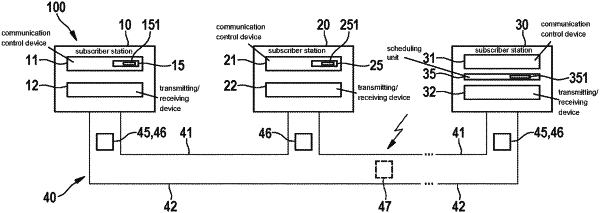| CPC H04L 12/413 (2013.01) [H04L 5/0078 (2013.01); H04L 17/30 (2013.01); H04L 7/00 (2013.01)] | 22 Claims |

|
1. A subscriber station for a serial bus system, comprising:
a communication control device configured to control a communication of the subscriber station with at least one other subscriber station of the bus system;
a transmitting/receiving device configured to transmit a transmission signal generated by the communication control device in a frame on a bus of the bus system; and
a scheduling unit configured to plan a temporal access of the subscriber station to the bus in at least one time slot of a cycle of temporally consecutive time slots, at least one time slot being provided in the cycle for each subscriber station of the bus for transmitting its transmission signal and the cycle being repeated cyclically so that there is a first instance of the cycle and one or more additional instances of the cycle;
wherein:
the scheduling unit is configured to determine, by using at least one item of information received from the bus, an assignment that specifies which time slot of the cycle the transmitting/receiving device may use for transmitting the frame for the transmission signal on the bus;
the assignment is generated in the first instance of the cycle by an arbitration, between transmission requests by the subscriber stations, that assigns to each of the subscriber stations that has provided a respective one of the transmission requests a respective one of the time slots of the first instance of the cycle, the assignment being used in the one or more additional instances of the cycle based on the arbitration that was performed in the first instance of the cycle, without arbitration occurring in the one or more additional instances of the cycle; and
the subscriber station includes at least one of the following five features (a)-(e):
(a) the at least one item of information received from the bus is a frame communicating a start of the cycle, and the at least one item of information received from the bus additionally includes a frame identifier and/or an assignment of the time slots of the cycle to the subscriber stations of the bus and/or information as to which of the subscriber stations of the bus is currently transmitting;
(b) the communication control device is configured to include a subscriber station number in the transmission signal which is assigned exclusively to the subscriber station on the bus, and the scheduling unit is configured to approve a temporal access of the subscriber station to the bus in the time slot assigned to the subscriber station when the scheduling unit is able to evaluate a subscriber station number in a frame received from the bus;
(c) the subscriber station is configured in such a way that the scheduling unit may be switched on or off depending on time requirements of the communication on the bus, or that an operating mode of the scheduling unit is changeable by configuration of predetermined parameters in a continuous operation of the bus system, the operating mode of the scheduling unit setting a predetermined mode of a communication on the bus;
(d) for each of the time slots assigned to the subscriber stations in the first instance of the cycle, the respective subscriber station to which the respective time slot is allotted a predefined transmit opportunity time period, which is shorter than an entirety of the respective time slot, in which to use the respective time slot in the one or more additional instances of the cycle, and, for any respective one of the one or more additional instances of the cycle in which the respective subscriber station does not begin use of the respective time slot within the predefined transmit opportunity, the respective time slot is reassigned for the respective cycle; and
(e) the arbitration is performed in the first instance of the cycle by:
selecting from all of the subscriber stations from which the transmission requests have been received for a temporally first one of the time slots; and
based on the selection performed for the temporally first one of the time slots, selecting, for a temporally second one of the time slots, from all of the subscriber stations from which the transmission requests have been received except for the subscriber station that has already been selected for the temporally first one of the time slots.
|